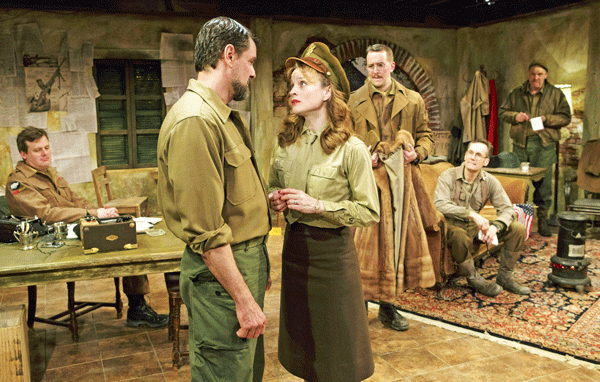
Mint Theater mines tale of ‘a journalistic Amelia Earhart’
BY JERRY TALLMER | I’m writing this — starting to write it — on what happens to be the 68th anniversary of D-Day. On that day, June 6, back in 1944, or perhaps it was the following day, one of the 130,000 young Americans, Brits and Canadians who outfaced hell to reach the beaches of Normandy was a Collier’s magazine war correspondent — a woman — named Martha Gellhorn.
Well, not all that young. Born November 8, 1908, she was going on 36 years old, and at the moment not a kosher war correspondent because her ex-husband-to-be, a fellow named Hemingway, had swiped her Collier’s assignment — and the military or the State Department or somebody had taken her credentials away even though (or because) she had been reporting on ferocious wars around the globe beginning with Loyalist Spain in 1937.
To get in on the D-Day landings, she locked herself in a hospital ship bathroom — two other hospital ships had been knocked out by mines — and then, disguised as a stretcher bearer, snuck ashore and got the first post-invasion story filed from France by any reporter, female or male.
This is the same Martha Gellhorn whom Hemingway, in his blistering three-act Madrid-based play “The Fifth Column” (a warm-up to “For Whom the Bell Tolls”), portrayed and/or caricatured as a spoiled, high-style, lazy, ill-informed, not-quite-bright gorgeous blonde and bedmate.
The same Martha Gellhorn — a journalistic Amelia Earhart — half the world was in love with, for her guts, her beauty and her convictions.
The same Martha Gellhorn to whom in “The Fifth Column” Hemingway has his anti-Fascist secret-agent playboy hero sneer: “Aren’t you a lady war correspondent or something? Get out of here and go write an article…”
The same Martha Gellhorn who, with her friend and fellow war correspondent Virginia Cowles, would in 1946 write the loosely autobiographical (times two) Ben Hecht-cum-Marx Brothers comedy, “Love Goes to Press,” that at long last now returns to the living stage in a spanking enjoyable production at Off-Broadway’s evergreen Mint Theater Company, three flights up (yes, by elevator) at 311 West 43rd Street.
“Love Goes to Press” had been a big hit at London’s Embassy and Duchess Theatres — but when it arrived in 1947 at the Biltmore (now the Friedman) on Broadway, minus star Irene Worth (who had stayed behind in Britain), it lasted but four or five (the records are conflicting) performances.
The setting of the play is, or was, what was called a “press camp” — typewriters, coffee, tea, booze, wise-cracking card-playing hardboiled newspapermen — during the stalled Allied advance on Rome, at the foot of a mountain much like the actual Monte Cassino.
Brought together there, by remarkable coincidence, are war correspondents Jane Mason (Angela Pierce) and Annabelle Jones (Heidi Armbruster); idiot-brained touring Hollywood star Daphne Rutherford (Margot White); cool, romantic British press officer Phillip Brooke-Jervaux (Bradford Cover); and a most obliging Corporal Cramp (Ned Noyes) — who keeps everybody fed and unpacked and reasonably warm. All that and — guess what — a swaggering, unscrupulous, hard-drinking American reporter named Ern…no, no, just plain Joe Rogers (Rob Breckenridge), a lover boy with “the character of a cobra.”
“Gellhorn and Cowles wrote it,” says “Love Goes to Press” director Jerry Ruiz, “in the style of romantic 1940s comedies, hoping to have it picked up as a film.” (It wasn’t). “When it got to New York, the critics found it too frivolous” — and perhaps, since all or most of those critics were male in those years, too uncomfortably close to home.
Yet oddly enough — or not so oddly, looking back through all these years of the women’s movement — the words “girl” or “girls” appear much more frequently throughout this play than the words “woman” or “women.” Still, there’s also this, at what rings as the crux of the whole matter:
JANE (to ANNABELLE): You needn’t worry about my politics. Only I don’t believe we do much good. Either you can’t write anything the way it really is, or else no one will believe you.
ANNABELLE: You have to go on trying.
JANE: You’re better at lost causes than I am. Personally I’ve reached the age when there’s nothing left but marriage.
ANNABELLE (the Gellhorn character): That’s the most defeatist statement I’ve ever heard.
One thinks of Martha Gellhorn as a pretty tough broad who had to battle for every inch of attention her whole life; deplored “all that objectivity shit” her whole life; was one of the first Allied reporters into Dachau (being half-Jewish herself on both her mother and father’s sides); left 17 books behind her (more than Hemingway); was a blonde beauty who broke a great many hearts; and took her own life via overdose, in London, age 89, when cancer and near total blindness made life no longer worth living.
Hemingway’s “The Fifth Column” had been done on Broadway way back in the spring of 1940 — I, as a teenager, trembled throughout it — with actors as good as Franchot Tone and Lee J. Cobb — but, thanks to changing political winds, “in an adaptation by Benjamin Glazer.”
In 2008, Mint Theater artistic director Jonathan Bank brought the pre-adapted “The Fifth Column” back word for word as Hemingway had written it, and during the run-up to that opening, the Mint did a staged reading of “Love Goes to Press” with then 30-year-old Jerry Ruiz as director.
Neither Ruiz nor Bank nor anybody else had ever heard of “Love Goes to Press.” It was Sandra Spanier, Professor of English and editor of the Hemingway Letters Project at Penn State University, who said to Bank: “You know, Martha Gellhorn wrote a play.” Gellhorn had let Ms. Spanier have it on one condition. “Could you just remove Hemingway?” Gellhorn didn’t wish to even hear his name.
Ruiz and others had wanted to do a production of “Love Goes to Press” right away, back there in 2008 — but, says Bank, “I thought we ought to wait until, first, our troops get pulled out of Iraq, and, second, until a publicized movie about Gellhorn had been made and released.” (Back in May, HBO aired “Hemingway and Gellhorn,” starring Nicole Kidman.)
“You know, Off-Broadway you look for any edge you can get. Riding on somebody else’s coattails? Just show me way,” Bank said.
Comedy or otherwise, it is difficult to see and/or read “Love Goes to Press” without thinking of the great chapter about El Sordo and his handful of men on that mountaintop vs. the waves of Fascist bombing planes in “For Whom the Bell Tolls.”
Here is the casualty report from one night on the slopes of another mountaintop, another war, the one in “Love Goes to Press:” 106 living, 52 wounded, 65 dead. No women on the scene.
Oh yeah?

















